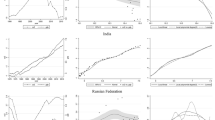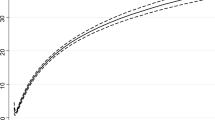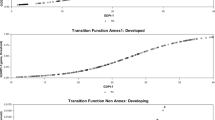Abstract
This study investigates the robustness and validity of the environmental Kuznets curve hypothesis for Brazil, Chile, China, Colombia, Egypt, Greece, India, Indonesia, South Korea, Malaysia, Mexico, Peru, the Philippines, Thailand, and Turkey. The hypothesis postulates the connection between pollution and income follows an inverted U-shaped path, which means that environmental degeneration rises with income during the beginning phases of economic growth; however, it declines after reaching a specified peak. For the empirical part of our study, we employed summability procedures designed to analyze the nonlinear long-term relationship for persistent processes. The yearly data consist of carbon dioxide emission and gross domestic product, both of which are expressed in per capita terms and cover the period from 1960 to 2014. The results illustrate the Environmental Kuznets Curve hypothesis holds for China, Colombia, India, South Korea, and the Philippines, which means that environmental problems wither away with economic growth and are resolved automatically without any need for policy action in these countries.
Similar content being viewed by others
Notes
The Kuznets Curve comes from the original work of Kuznets (1955) who estimated the dynamic relationship between income inequality and GNP per capita. According to Kuznets (1955), income distribution inequality increases with the rise in per capita income until a particular point, and after that point, if per capita income continues to rise, then income inequality decreases significantly.
The sample countries come from the MSCI Emerging Markets Index generated by Morgan Stanley Capital International to measure equity market performance of emerging markets. For details, see https://www.msci.com/emerging-markets.
Assuming for illustration \(g(x_{t} ) = \theta_{1} x_{t} + \theta_{2} x_{t}^{2}\), let \(x_{t} = x_{t - 1} + x_{0} + \varepsilon_{t}\) and \(\varepsilon_{t} \sim i.i.d.(0,\sigma_{\varepsilon }^{2} )\), then it is obtained \(\text{var} (x_{t} - x_{t - 1} ) = \sigma_{\varepsilon }^{2} \Rightarrow x_{t} \sim I(1)\). In other words, Engle and Granger (1987) characterization of a stationary process holds for \(\Delta x_{t}\) (finite variance). The same property can be investigated for \(\Delta x_{t}^{2}\): \(\text{var} (x_{t}^{2} - x_{t - 1}^{2} ) = {\rm E}(\varepsilon_{t}^{4} ) + 4(t - 1)\sigma_{\varepsilon }^{4} - \sigma_{\varepsilon }^{4} \Rightarrow x_{t}^{2} \sim I(?)\). It can be seen that the finite variance characteristic is clearly violated given that the variance is a function of time. Because this problem cannot be solved by further differencing, it is not possible to determine the order of integration of \(x_{t}^{2}\). The difficulty arises from the requirement of the Engle and Granger (1987) characterization to investigate the differences of a process, with the intrinsic linearity of the difference operator creating obvious problems for nonlinear processes. For technical details, refer to Eberhardt and Presbitero (2015).
References
Akbostanci, E., Turut-Asik, S., & Tunc, G. I. (2009). The relationship between income and environment in Turkey: Is there an environmental Kuznets curve? Energy Policy, 37(3), 861–867.
Alam, M., Murad, W., Noman, A. H., & Ozturk, I. (2016). Relationships among carbon emissions, economic growth, energy consumption and population growth: Testing environmental Kuznets curve hypothesis for Brazil, China, India and Indonesia. Ecological Indicators, 70, 466–479.
Al-Mulali, U., Tang, C. F., & Ozturk, I. (2015). Estimating the environment Kuznets curve hypothesis: Evidence from Latin America and the Caribbean countries. Renewable and Sustainable Energy Reviews, 50, 918–924.
Berenguer-Rico, V., & Gonzalo, J. (2013). Co-summability: From linear to non-linear cointegration. Universidad Carlos III de Madrid working paper (no. 13–12).
Berenguer-Rico, V., & Gonzalo, J. (2014). Summability of stochastic processes: A generalization of integration for non-linear processes. Journal of Econometrics, 178, 331–341.
Dasgupta, S., & Heal, G. M. (1979). Economic theory and exhaustible resources. Cambridge: Cambridge University Press.
Dasgupta, S., Laplante, B., Wang, H., & Wheeler, D. (2002). Confronting the environmental Kuznets curve. Journal of Economic Perspectives, 16(1), 147–168.
Dinda, S. (2004). Environmental Kuznets curve hypothesis: A survey. Ecological Economics, 49(4), 431–455.
Eberhardt, M., & Presbitero, A. F. (2015). Public debt and growth: Heterogeneity and non-linearity. Journal of International Economics, 97(1), 45–58.
Engle, R. F., & Granger, C. W. (1987). Co-integration and error correction: Representation, estimation, and testing. Econometrica: Journal of the Econometric Society, 55(2), 251–276.
Ghosh, S. (2010). Examining carbon emissions economic growth nexus for India: A multivariate cointegration approach. Energy Policy, 38(6), 3008–3014.
Gonzalo, J., & Pitarakis, J. (2006). Threshold effects in cointegrating relationships. Oxford Bulletin of Economics and Statistics, 68, 813–833.
Govindaraju, V. C., & Tang, C. F. (2013). The dynamic links between CO2 emissions, economic growth and coal consumption in China and India. Applied Energy, 104, 310–318.
Grossman, G. M., & Krueger, A. B. (1991). Environmental impacts of a North American free trade agreement, National Bureau of Economic Research, working paper 3914.
Grossman, G. M., & Krueger, A. B. (1995). Economic growth and the environment. The Quarterly Journal of Economics, 110(2), 353–377.
Holtz-Eakin, D., & Selden, T. M. (1995). Stoking the fires? CO2 Emissions and economic growth. Journal of Public Economics, 57(1), 85–101.
Hong, S. H., & Wagner, M. (2008). Nonlinear cointegration analysis and the environmental Kuznets curve. Reihe Ökonomie/Economics series no. 224, Institut für Höhere Studien (IHS).
Kijima, M., Nishide, K., & Ohyana, A. (2010). Economic models for the environmental Kuznets curve: A survey. Journal of Economic Dynamics and Control, 34(7), 1187–1201.
Kuznets, S. (1955). Economic growth and income inequality. The American Economic Review, 45(1), 128.
Lee, H. H., Chung, R. K., & Koo, C. M. (2005). On the relationship between economic growth and environmental sustainability. In Ministerial conference on environment and development in Asia and Pacific (p 26).
Meadows, D. H., Meadows, D. L., Randers, J., & Behrens, W. W. (1972). The limits to growth. New York: Universe Books.
Monserrate, M. A. Z., Bajana, I. V., Bohorquez, J. A., & Jimenez, M. M. (2016). Relationship between economic growth and environmental degradation: Is there evidence of an environmental Kuznets curve for Brazil? International Journal of Energy Economics and Policy, 6(2), 208–216.
Narayan, P. K., & Narayan, S. (2010). Carbon dioxide emissions and economic growth: Panel data evidence from developing countries. Energy Policy, 38(1), 661–666.
Nasr, A. B., Gupta, R., & Sato, J. R. (2015). Is there an environmental kuznets curve for South Africa? A co-summability approach using a century of data. Energy Economics, 52, 136–141.
Onofowora, O. A., & Owoye, O. (2014). Bounds testing approach to analysis of the environment Kuznets curve hypothesis. Energy Economics, 44, 47–62.
Panayotou, T. (1997). Demystifying the environmental Kuznets curve: Turning a black box into a policy tool. Environment and Development Economics, 2(4), 465–484.
Pao, H. T., & Tsai, C. M. (2011). Multivariate granger causality between CO2 emissions, energy consumption, FDI (foreign direct investment) and GDP (gross domestic product): Evidence from a panel of BRIC (Brazil, Russian Federation, India, and China) countries. Energy, 36(1), 685–693.
Saboori, B., & Jamalludin, S. (2013). CO2 Emissions, energy consumption and economic growth in Association of Southeast Asian Nations (ASEAN) countries: A cointegration approach. Energy, 55, 813–822.
Stern, D. I. (2004). The rise and fall of the environmental Kuznets curve. World Development, 32(8), 1419–1439.
Stern, D. I., Common, M. S., & Barbier, E. B. (1996). Economic growth and environmental degradation: The environmental Kuznets curve and sustainable development. World Development, 24(7), 1151–1160.
Yuan, J. H., Kang, J. G., Zhao, C. H., & Hu, Z. G. (2008). Energy consumption and economic growth: Evidence from China at both aggregated and disaggregated levels. Energy Economics, 30(6), 3077–3094.
Acknowledgements
We wish to thank the anonymous referee for many helpful comments. Special thanks go to the Editor for allowing us the opportunity to revise our work. Any remaining errors are solely ours.
Author information
Authors and Affiliations
Corresponding author
Additional information
Publisher's Note
Springer Nature remains neutral with regard to jurisdictional claims in published maps and institutional affiliations.
Rights and permissions
About this article
Cite this article
Bozoklu, S., Demir, A.O. & Ataer, S. Reassessing the environmental Kuznets curve: a summability approach for emerging market economies. Eurasian Econ Rev 10, 513–531 (2020). https://doi.org/10.1007/s40822-019-00127-z
Received:
Revised:
Accepted:
Published:
Issue Date:
DOI: https://doi.org/10.1007/s40822-019-00127-z
Keywords
- Balancedness
- CO2 emissions
- Co-summability
- Emerging markets
- Environmental Kuznets curve
- Nonlinear co-integration




